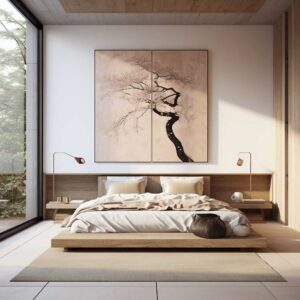Designs in the Zen style merge harmoniously the aesthetics and philosophy of a space created with features of serenity, simplicity, and harmony. Drawing so much from the calm aesthetic and minimalistic beauty of the traditional Japanese home, the design perfectly integrates natural elements, subdued colors, and clean lines to foster a spirit-full living space replete with tranquility. The art of doing home interior design in this Zen style is not so much decoration but creating an atmosphere and environment in which calm and consciousness might be cultivated.
Soothing Zen Style Living Room Elegance
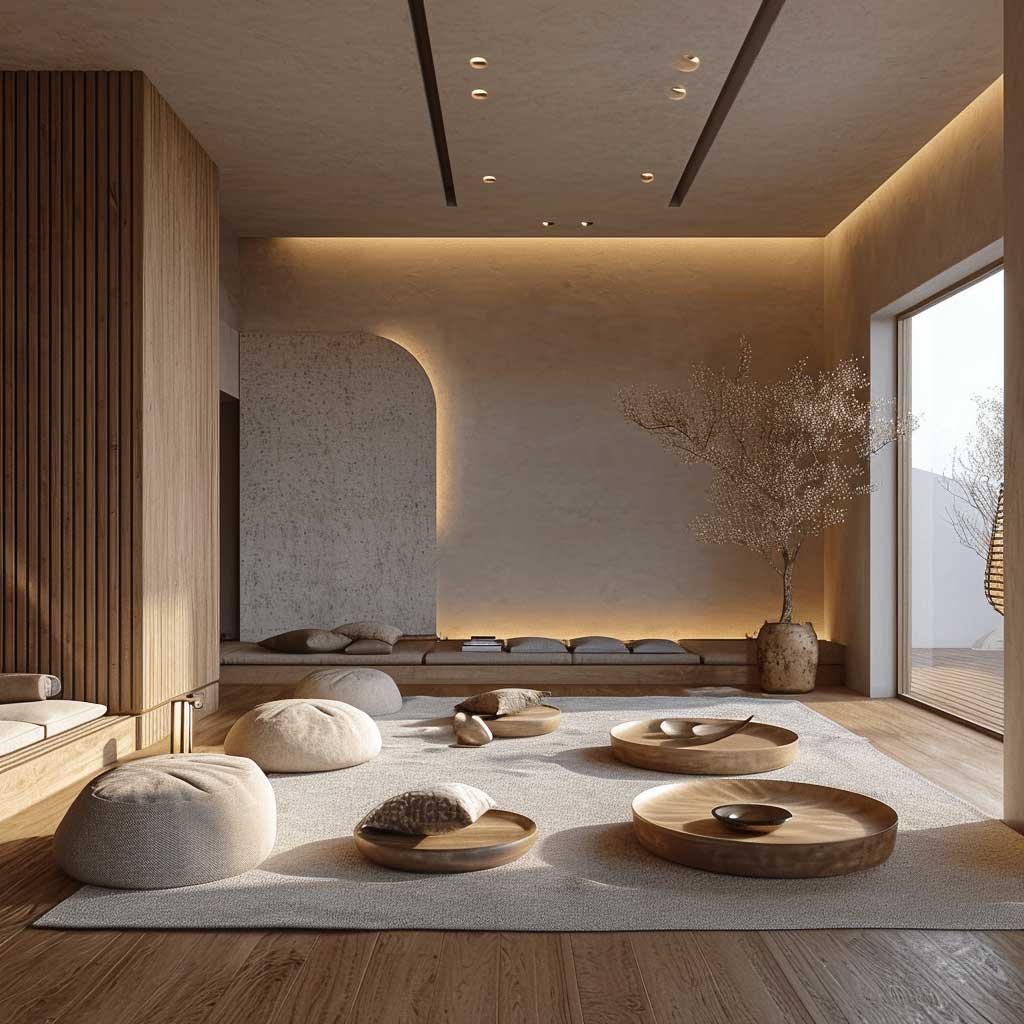



In the context of interior design and with Zen style emerging as a beacon of tranquility and elegance, the living room represents the heart of each house. This one is deeply rooted in the minimalist philosophy of Zen Buddhism, which puts more emphasis on the virtue of creating a space that should inspire not only the eyes but also the mind and spirit. In interior decoration, the Zen style of living rooms highlights simplicity, natural elements, and maintaining a balance between an aesthetic look and functionality.
The feature of a Zen-style living room is minimalism. Unlike other styles that may encourage decorative excess, Zen spaces are defined by a distinct lack of clutter. Everything in the room is handpicked for intent and purpose. The furniture is plain, with clean lines and natural materials like wood and stone predominant. This does not mean that there is no comfort or warmth; in fact, it means that one can relax and find peace in such a place.
Color is also essential to the overall Zen interior design style. Usually, living rooms in this style have a neutral and earthy palette. Commonly, soft beiges, warm grays, and muted greens are thus standard, hence creating a relaxing background that reflects the natural world. Serene properties emanating from these colors give a calming effect that invariably helps one relax and think deeply.
Another thing of prime importance in a Zen living room is natural light. The same infuses with large windows, skylights, or whatever other means into the design of this particular type of living room. This has not only made the room feel very open and light but has also helped to establish a strong connection with the outside. And even if natural light is not an option, lighting fixtures are selected for their ability to mimic the natural light source. At the same time, preference is given to the shed of a soft, diffuse light source over harsh, direct light sources.



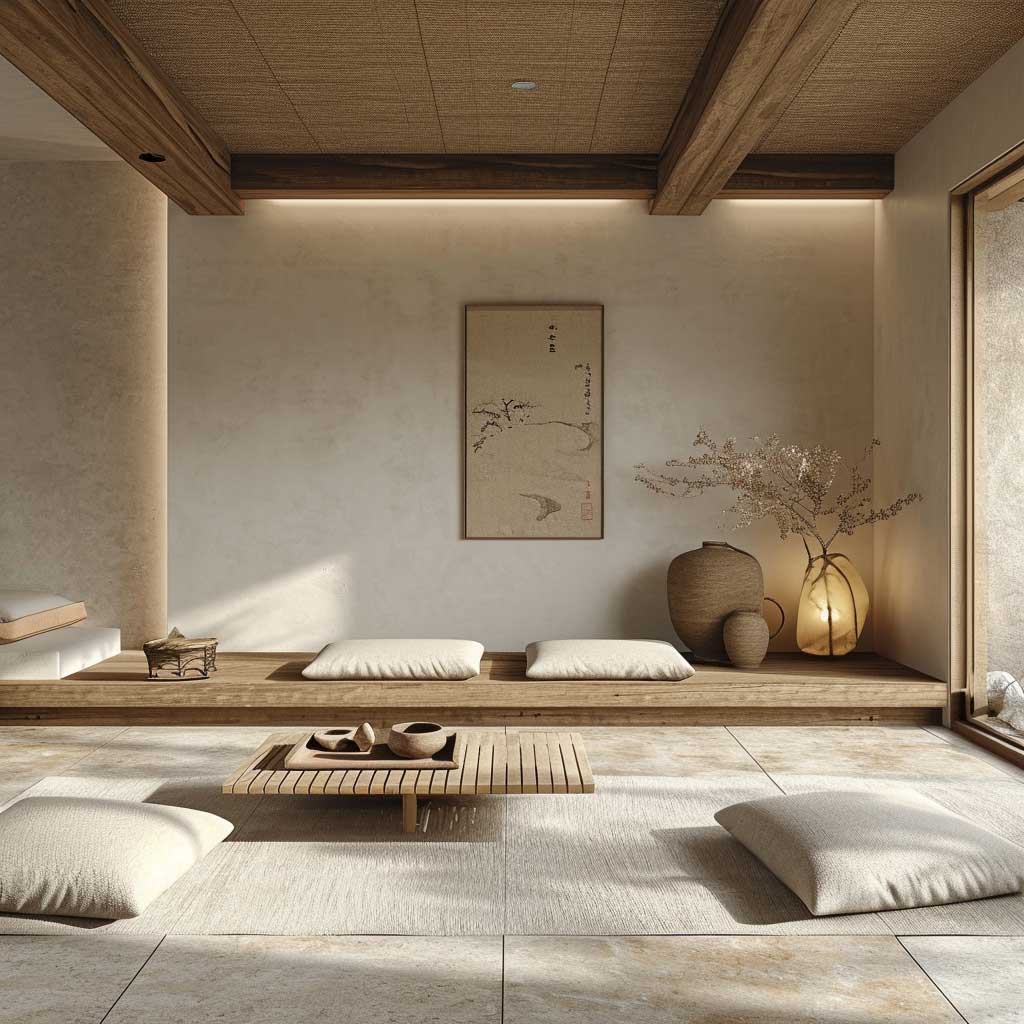
In line with nature, some of the elements that could be found in a Zen living room are indoor plants, water features, or natural fiber rugs. These bring a piece of the natural world indoors, making one feel at ease. Most interestingly, these plants enhance indoor air quality and give life to the space.
Harmonious and flowing: A Zen-style living room layout is never considered. The furniture will be laid out to promote movement without blocking space. There is an emphasis on symmetry and balance, and each piece of furniture and decor is so carefully placed as not to lose a sense of order and calm.
Textures are also crucial for a Zen living room. Upholstery, curtains, and cushions favor soft, natural fabrics. These textures additionally contribute to the general feeling of comfort and relaxation in the room. With its varieties and shades, wood gives natural warmth and is often resorted to for floors as well as furniture and accent pieces since they add depth and character to the space.
The Zen living room is not a physical dimension but a reflection of the inner mind where peace and calmness are prioritized, simplicity in all aspects upheld, and the appreciation of beautiful natural things. It is crafted not only for living but to help locate peace and clarity from all the bustles of life. The principles of the style are in creating a sanctuary for unwinding, thinking, and restoration in a modern way typical of Zen interiors.
Zen Inspired Bedroom Retreat for Ultimate Relaxation
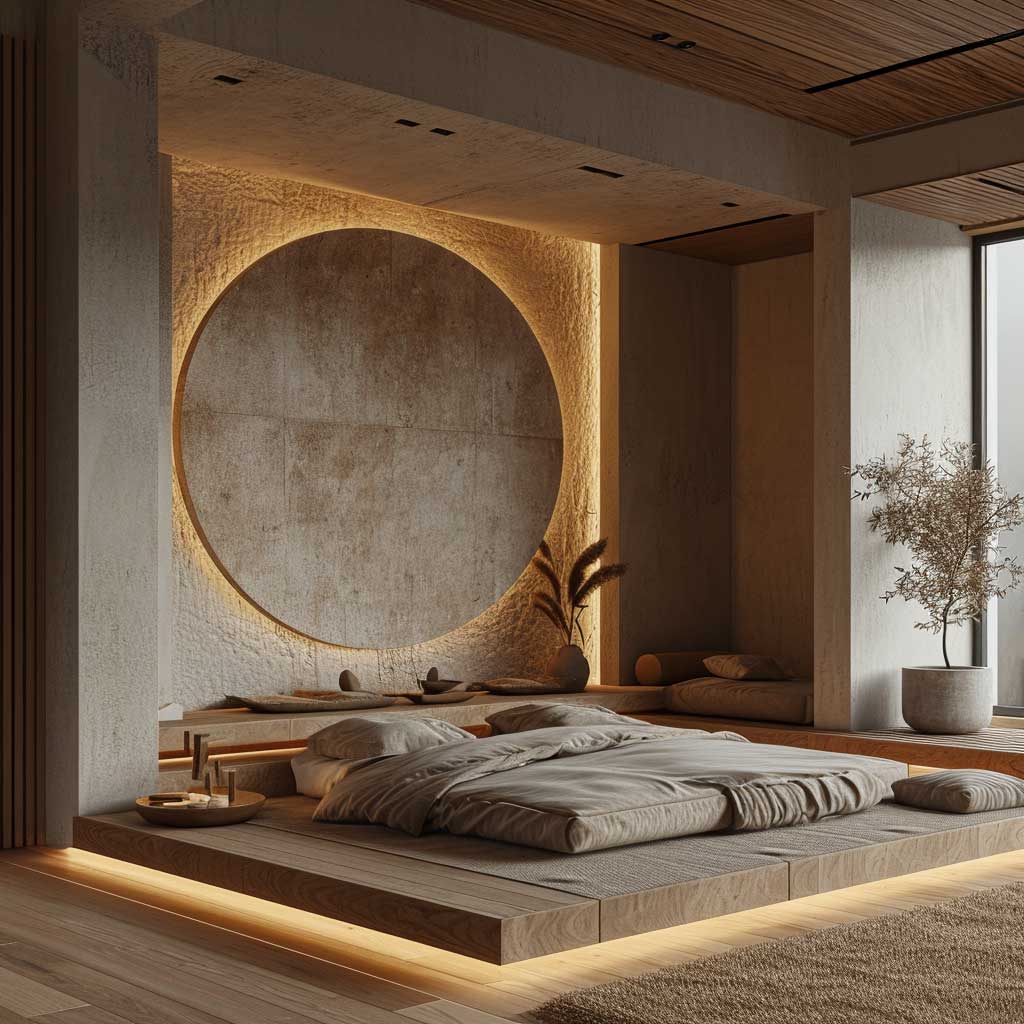
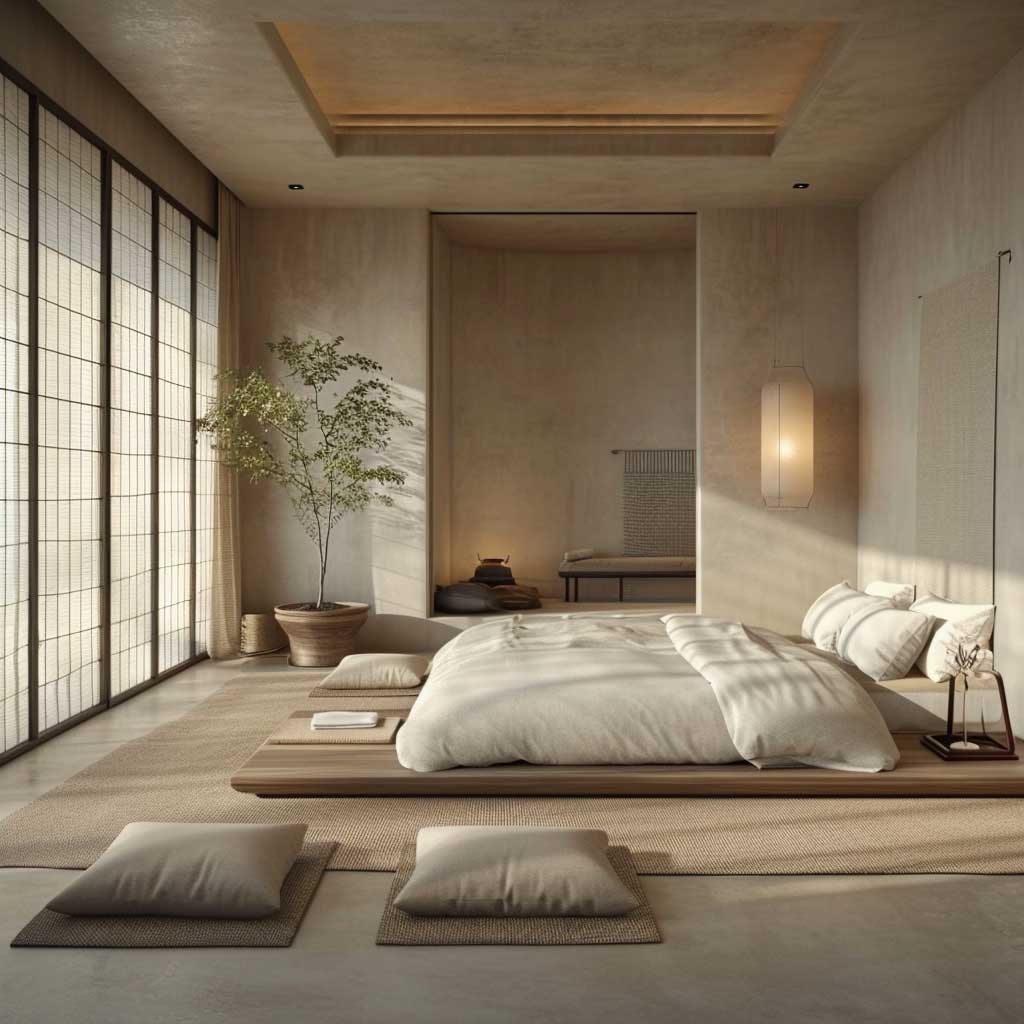
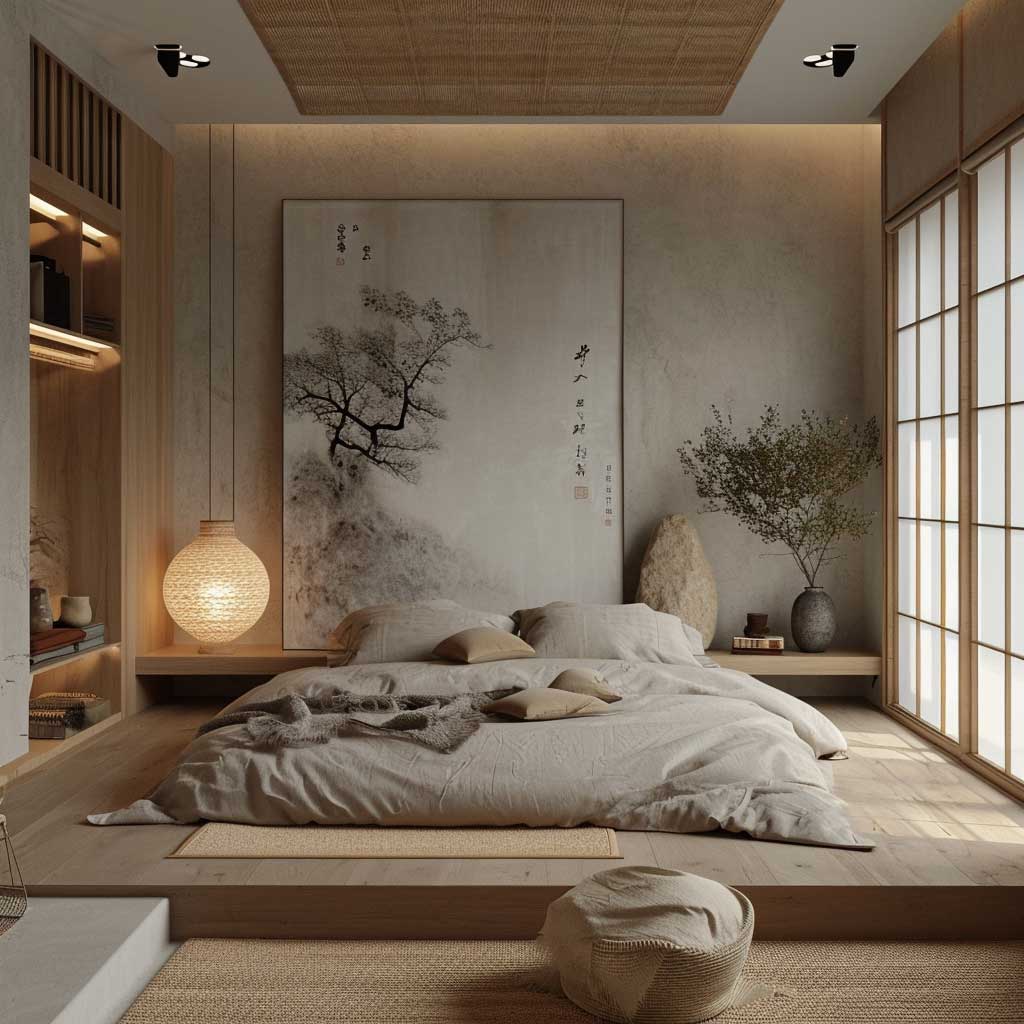

A bedroom becomes a personal retreat for relaxation when styled with Zen-style interior principles. In this modern era where everyone is so stressed and lives life quickly, a Zen bedroom will take you to far-off realms of rest and tranquility. Minimalism is the essence of Zen ideals: simplicity and non-complexity in life. The design of the bedroom speaks right all over. A Zen bedroom carries the fewest amount of furniture and decor possible. Where furniture is used, it can be a low bed with accessories like side tables and possibly a sleek dresser. Not only are these pieces functional, but they’re explicitly selected to promote a calm and orderly disposition.
The color scheme in a Zen bedroom is usually subdued and nature-inspired. Soft pastel colorings, such as light green, various gray tones, and creamy white shades, all blend to make it look calming and restful. Still, these colors are gentle on the brain. It is ideal for taking naps, so it is most appropriate for a room where one plans to spend most of their time relaxing or sleeping.
The most prominent characteristic of a Zen bedroom is the presence of natural materials, with the wooden flooring and wooden furniture, that feels heartwarming and very grounding. Beddings, curtains, and furniture are all upholstered with fabric from linen, cotton, and other natural fabrics. This gives the room texture that makes it much warmer and cozier.
Lighting is essential in a Zen bedroom. It uses soft and excellent lighting, and if the day lightens up, it takes to the maximum use of the natural light coming from out. Maintained at night with soft, diffused lighting. Candles or dimmable lamps can add that extra little bit of tranquility to any room.
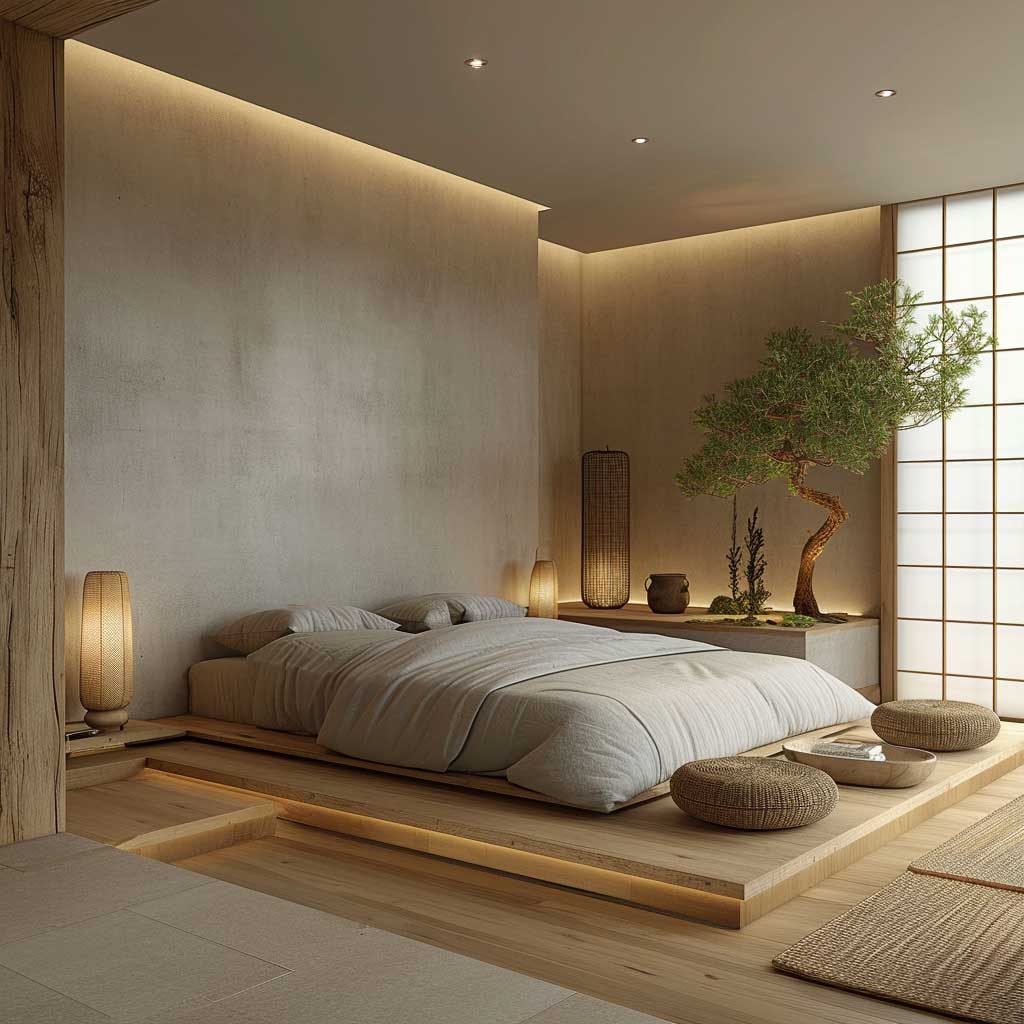



To further create the Zen atmosphere in the bedroom, natural elements are typically found. A little water feature, some indoor plants, or a small vase with flowers will give you a taste of the exterior inside. These things not only increase the beauty of the space but also improve the connectedness to nature.
A Zen bedroom layout usually instills the feeling of peace and balance since beds are primarily placed in such a manner that someone will be able to move around the room with ease, facing a window or even an artwork that brings a spark of peace inside oneself. The overall arrangement is symmetrical and balanced, creating a sense of stability and calm.
In a Zenned-out bedroom, every element works together to create a calming environment. It’s the space for hustle and bustle to be left behind and tranquility and peace found. Not only are bedrooms designed with the Zen taste focused on creating a visual interest area, but they also seek to nurture the spirit and calm the mind.
Textures in a Zen bedroom are selected purposely to make calmness more effective. Here, you will see soft natural fabrics in bedding, window treatments, and rugs that evoke relaxation and comfort. Smooth, polished wood or stone provides a textural dimension that roots any space within a Zen bedroom back to the natural world.
A Zen bedroom pays attention to detail. Ornamentation is kept to a minimum, with each piece chosen for what it adds to the overall sense of peacefulness. Art is usually simple and nature-based, and the ornamental accessory is typically handcrafted or sourced from the natural environment, such as stones, shells, or wood artifacts.
Technology is slightly kept at a minimum inside Zen bedrooms; this is to maintain an atmosphere for relaxation. If there are gadgets, they are hidden or incorporated in such a way that does not destroy the soothing environment. The main focus is on creating a space that provides refuge from contemporary bustle and distractions.
Tranquil Zen Style Home Office for Productive Serenity
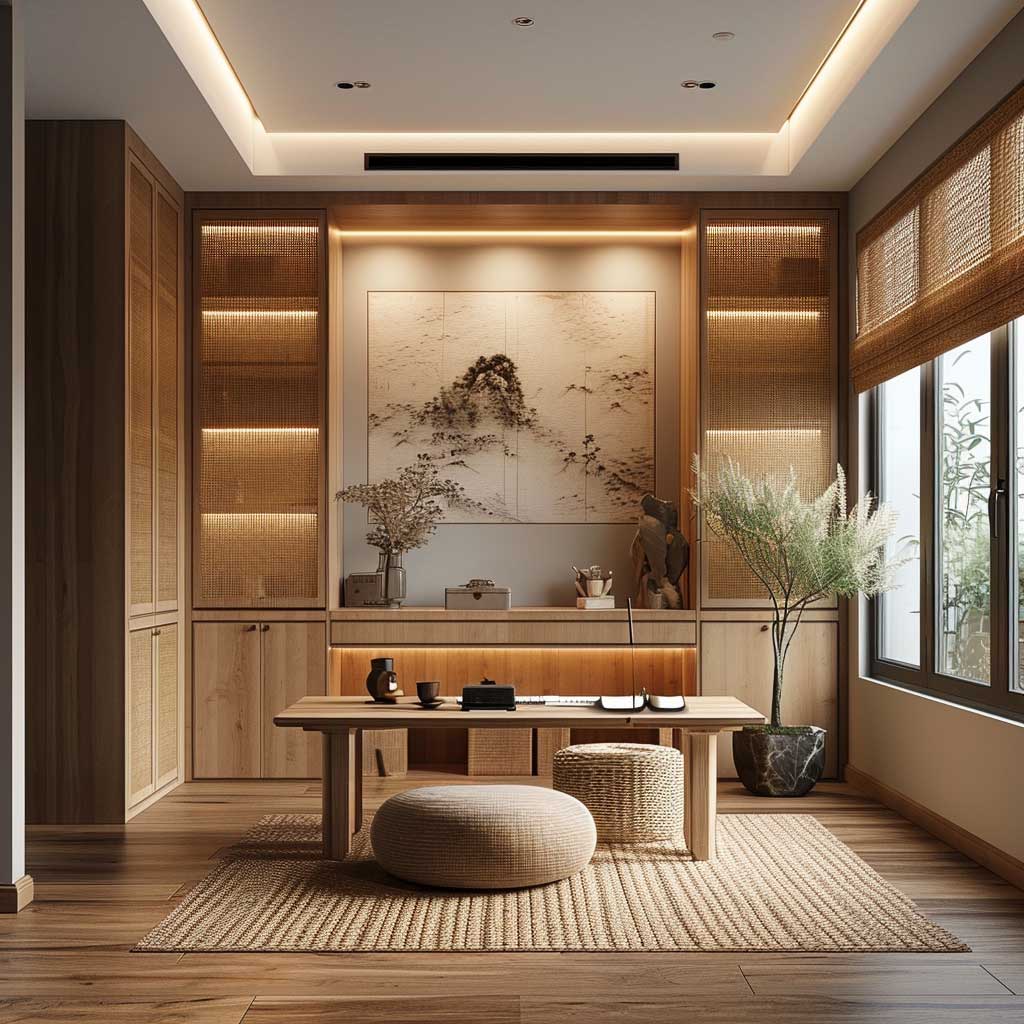

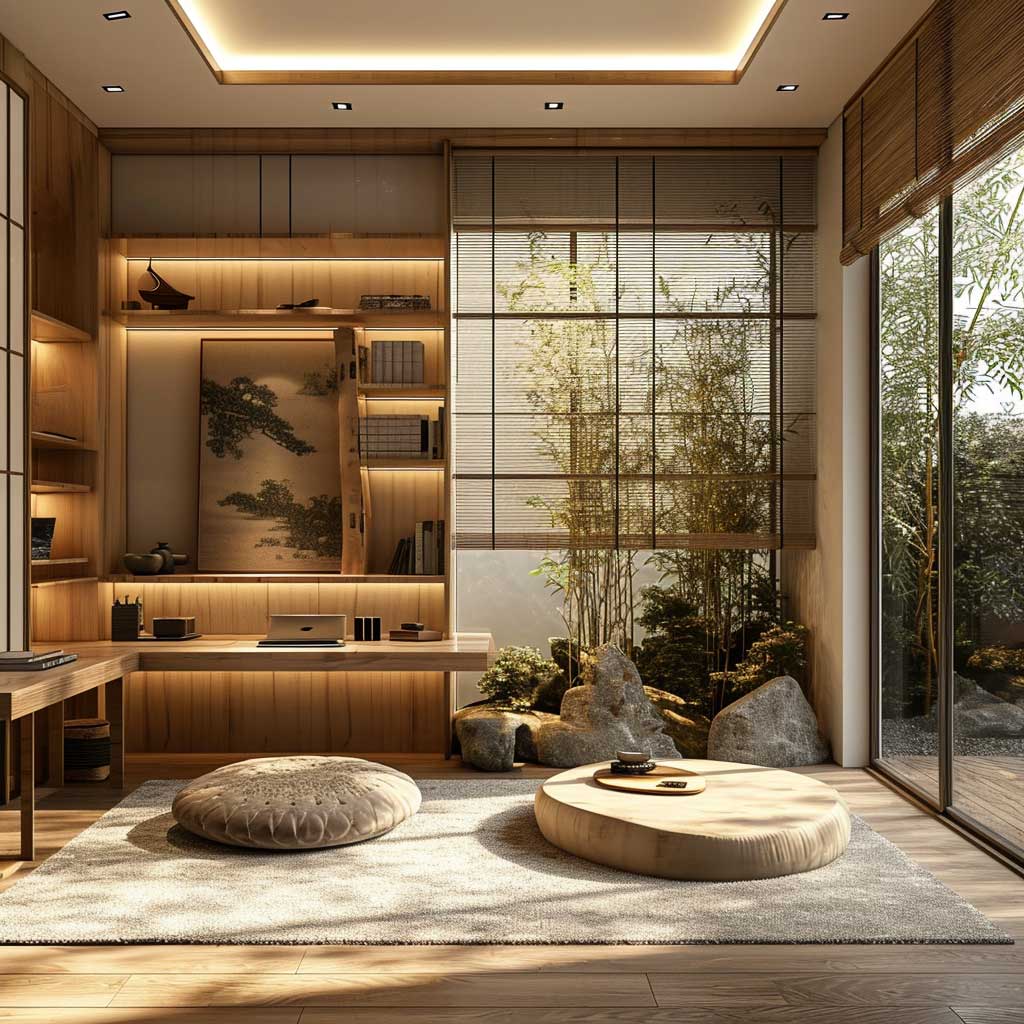
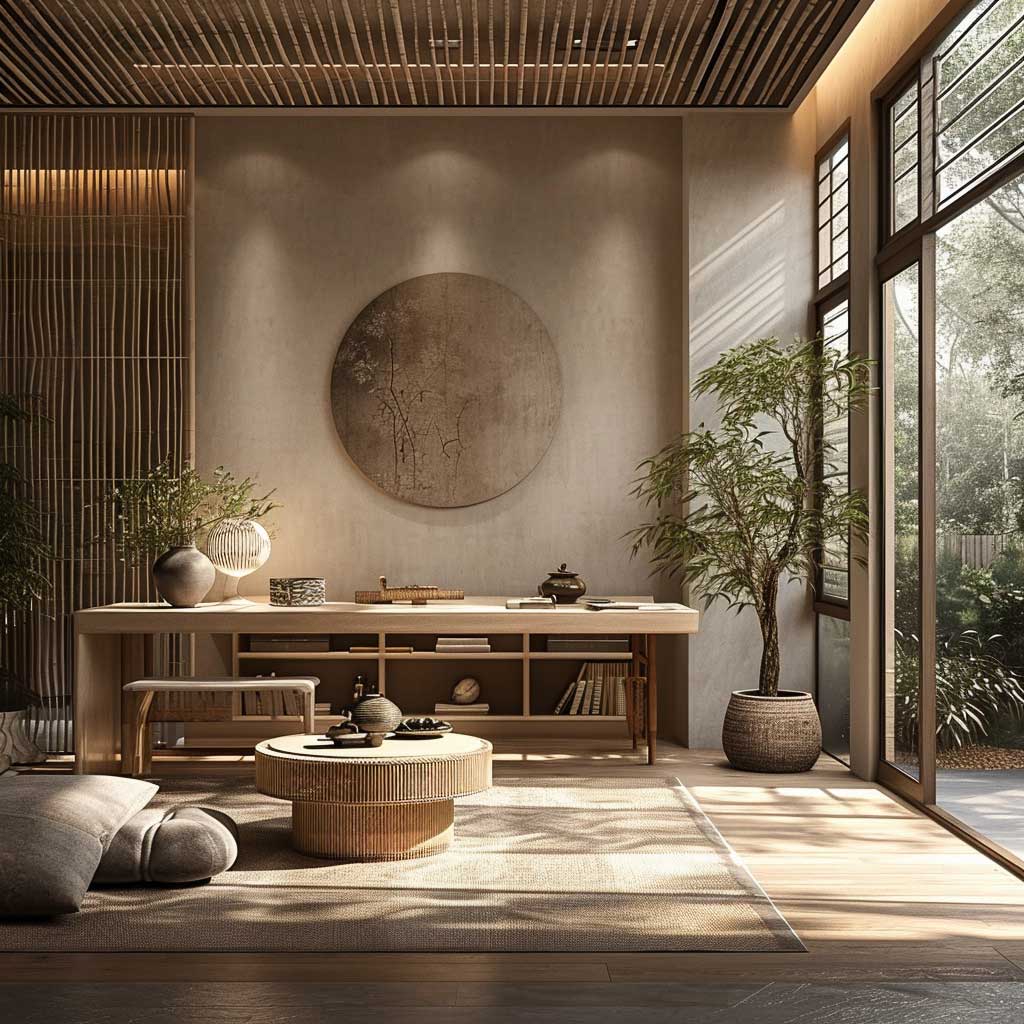
The design concept of Zen style in home offices is gaining ground since a balance between work productivity and tranquility has to be maintained. Nowadays, when life is in eighth gear, maintaining an equilibrium between work productivity and tranquility in a home office is an indispensable luxury. A Zen-style home office does just that—combines design aesthetics with elements that create a compelling and calm way to work.
The first principle in Zen design is minimalism, and this works best in an office at home. This will help to cut down on distractions and make for a clean, focused atmosphere. Furniture in a Zen office is simple and functional, with hardly any ornate detailing or carving but of clean lines. The basics would, therefore, consist of a sturdy, uncluttered desk, a comfortable yet straightforward chair, and adequate storage solutions. This bare look of the furniture keeps the place ordered and spaced out, hence very necessary to maintain a clear head for concentration.
The color palette of a Zen-style office is soothing and understated, drawing inspiration from natural hues. Popular choices are soft greens, grays, and beiges which create a calm and balanced atmosphere. These colors are considered to reduce stress and help one concentrate on what they are doing, thus making them suitable for an office.
Natural lighting is another element in the Zen office. Natural lighting helps to strain one’s eyes less; it ensures that one is in a better mood and has some energy. Consequently, the office space is organized whenever it is possible and feasible to ensure that maximum natural light is gained. Soft, natural sources of artificial lighting are provided so that the calm atmosphere is not disturbed when there is not enough natural light.
Nature is essential in the conceptual stage of Zen design, which is also true for the office. Using elements such as plants or a minor water feature will give staff a sense of being directly outside, thereby increasing the Zen feeling of a workspace. This is majorly made possible by plants that not only decorate a space but also play a significant role in air purification, thereby encouraging a healthy environment. The presence of such natural elements enables a much more stress-relieving environment and inspiration; hence, productivity and creativity are likely to benefit from such a change.
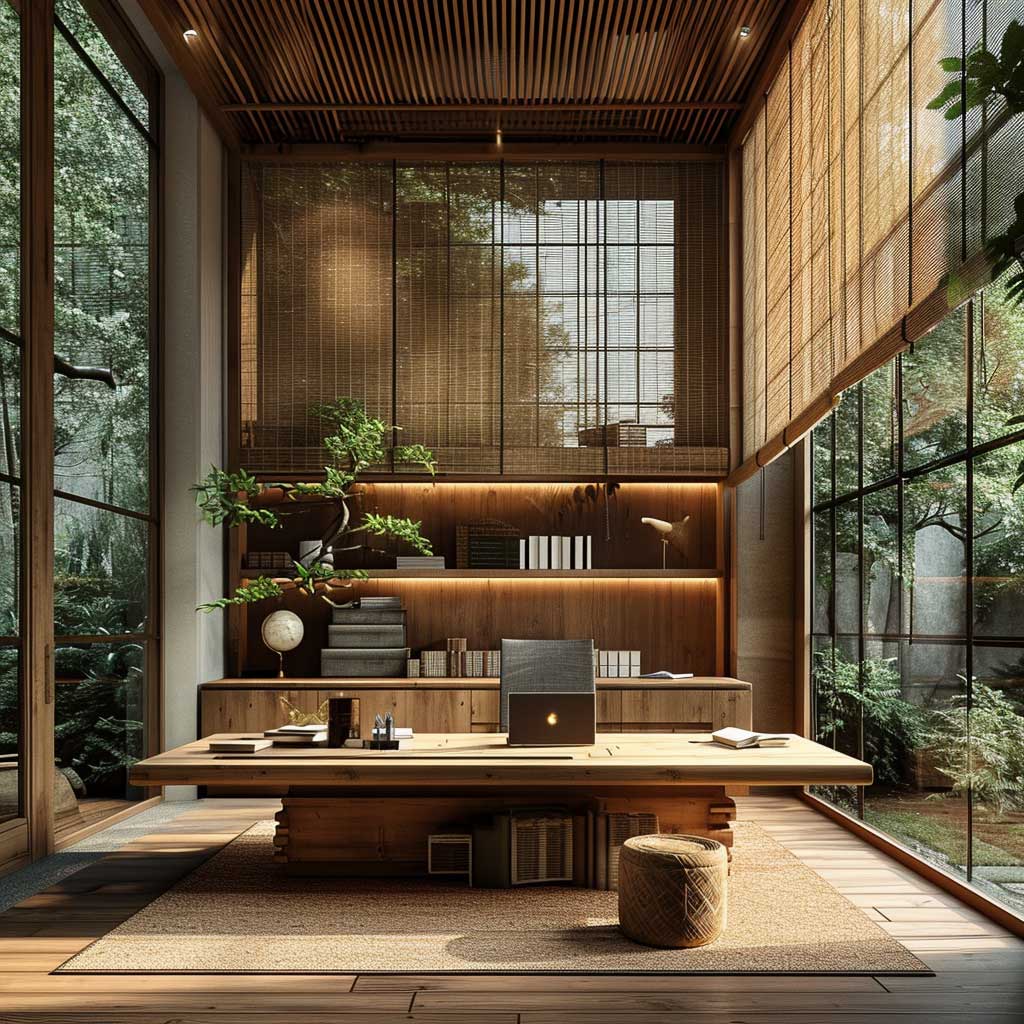
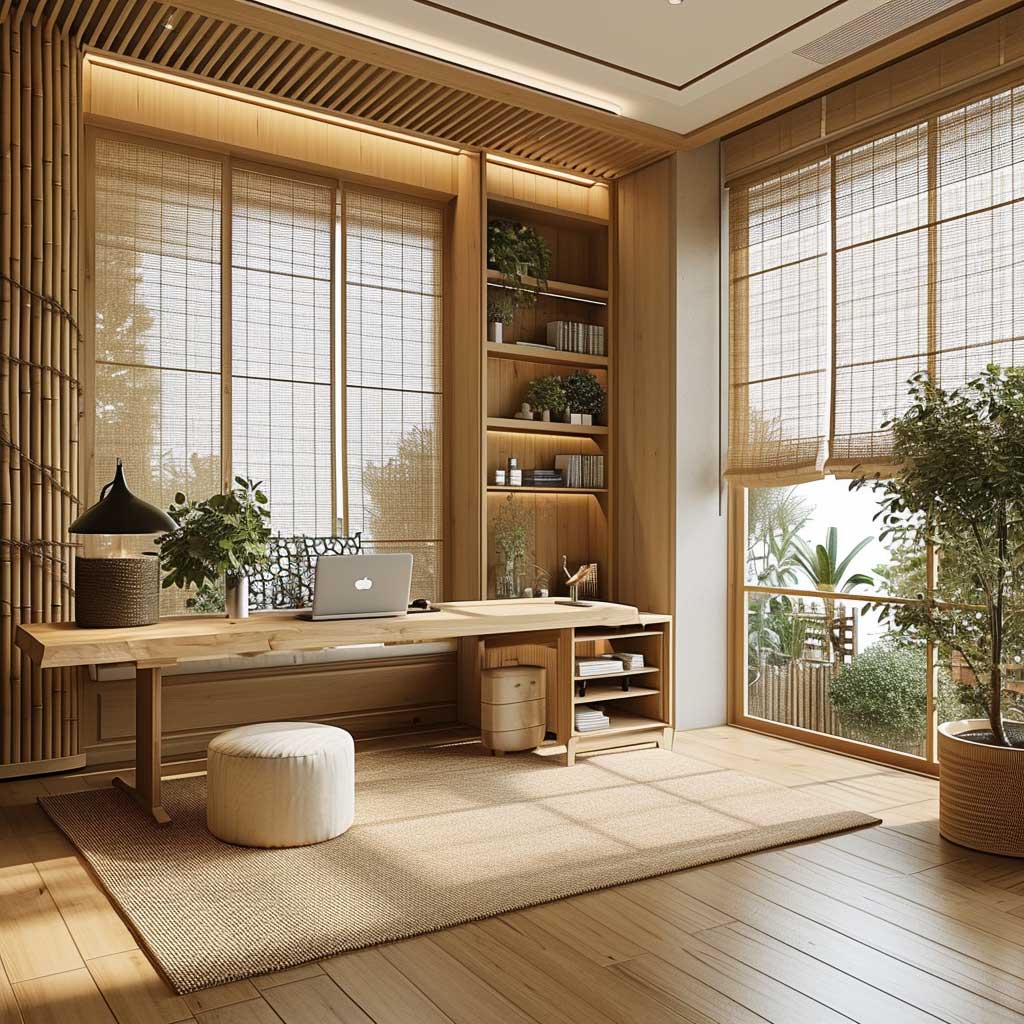
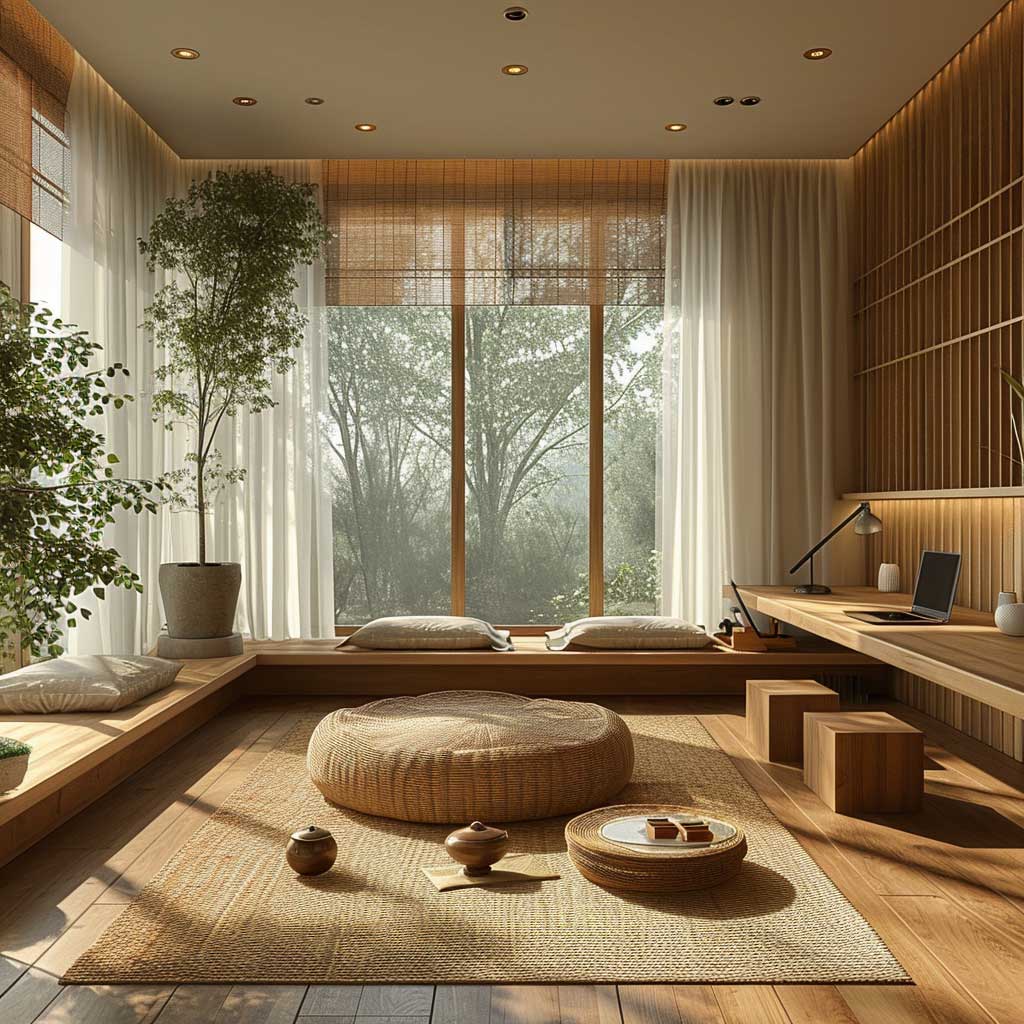

The arrangement of this Zen-style office makes the entire workplace designed for efficiency and easy movement. It’s open and airy, which means you can’t clutter it with all other kinds of furniture, including decorations. This way, a clutter-free environment can be kept, which is essential to help one think clearly and focus. The placement of the desk should be taken into proper consideration so that it faces toward a source of natural light or view to evoke the mood and productivity of an individual.
Textural elements in a Zen home office are very subtle yet significant. Textures should be organic, overtly using wood, bamboo, and stone. They warm the space by binding the inside world with the natural one that lies outside. Soft textiles, like a luxury pile rug or curtains in natural fabric, also add to the peacefulness within and provide the feeling of comfort and calm.
This is a Zen-style home office; it has technology, but it is not overwhelming. Devices and wires are placed appropriately so that the look is clutter-free. Here, the use of technology is balanced through the use of a minimalist and natural theme in totality so that it supports productivity without dominance over space.
In conclusion, the Zen-style home office will be form and function combined; it will look like it was created not just for work but for a peaceful aura. Using minimalist design, natural elements, and harmony in layout creates a sanctuary away from distractions and strains of the outside world. This is the not-so-common approach to office design where more than an aesthetic choice will enhance work quality and life—truly living out the spirit of Zen in every possible way.
Zen style interior design offers a unique approach to creating living spaces that are not just physically appealing but also emotionally soothing. By focusing on minimalism, natural elements, and a sense of tranquility, Zen style transforms homes into sanctuaries of peace and relaxation. This design philosophy encourages us to declutter not only our physical surroundings but also our minds, fostering an environment conducive to well-being and mindfulness. As we continue to seek balance in our hectic lives, the gentle art of Zen style in home interior design stands out as a pathway to achieving harmony and simplicity in our personal spaces.

